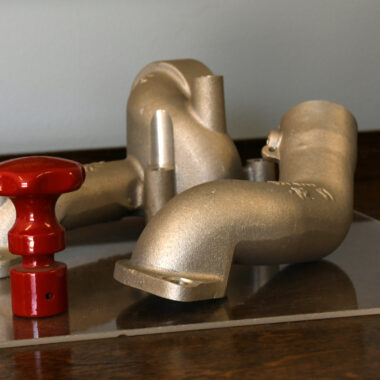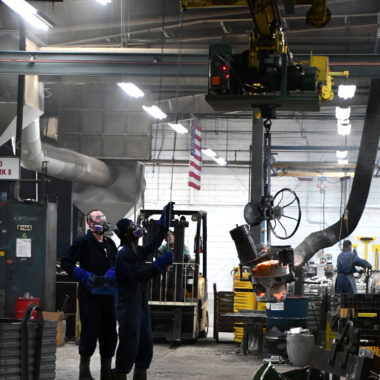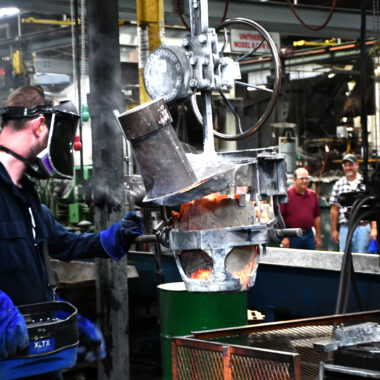Technology in Aluminum Casting: Cutting-Edge Techniques for Modern Developers
What absolutely establishes these developments apart are the sustainable light weight aluminum alloys being created and the high-pressure die casting techniques that are revolutionizing the sector. Join us as we discover the leading edge of aluminum spreading advancement, where innovation meets creative thinking to redefine what is feasible in the world of steel spreading.

Advanced 3D Printing Techniques
Using sophisticated additive manufacturing processes, advanced 3D printing methods have actually revolutionized the production of elaborate and tailored light weight aluminum parts. By employing high-precision printers that can work with aluminum powders or filaments, makers can develop intricate geometries and layouts that were previously unattainable through conventional manufacturing techniques.
Among the crucial benefits of innovative 3D printing in light weight aluminum part manufacturing is the capacity to attain light-weight yet sturdy frameworks. This is specifically valuable in sectors such as aerospace and auto, where weight decrease is essential for boosting gas performance and total efficiency. Furthermore, the personalization options provided by 3D printing allow for the manufacturing of special and tailored parts that meet particular demands, leading to improved performance and performance.
In addition, the efficiency of the 3D printing process reduces product waste and minimizes the total production time, making it an economical solution for making light weight aluminum components. As technology proceeds to development, the abilities of 3D printing in aluminum manufacturing are expected to expand, supplying even greater opportunities for development in various sectors.
Computer-Aided Design Innovations
With the innovations in sophisticated 3D printing techniques for light weight aluminum components, the assimilation of Computer-Aided Design (CAD) software program has come to be progressively pivotal in driving advancement and efficiency in the production process. CAD advancements have reinvented the way developers and designers produce light weight aluminum casting mold and mildews by offering exact electronic modeling abilities. These software program tools enable for the production of elaborate layouts and simulations that optimize the casting procedure, resulting in better components.
One of the crucial advantages of CAD in aluminum casting is the capacity to detect prospective concerns early in the layout phase, minimizing pricey errors and rework during manufacturing. By imitating the casting process essentially, developers can assess factors such as cooling rates, product circulation, and architectural honesty before a physical mold is produced. This positive strategy not only saves time and resources however likewise makes sure that the last light weight aluminum parts fulfill the desired specifications.
Furthermore, CAD software application allows quick versions and adjustments to styles, assisting in fast prototyping and modification to fulfill certain needs. By leveraging CAD technologies in light weight aluminum spreading, makers can enhance their procedures, boost product top quality, and remain at the forefront of innovation in the industry.
High-Pressure Pass Away Casting Approaches
High-pressure die spreading techniques are extensively identified for their effectiveness and precision in producing complex light weight aluminum parts. By making use of high pressure to force liquified light weight aluminum right into elaborate molds at quick rates, this method enables the production of thorough and dimensionally precise components. One of the key benefits of high-pressure die spreading is its ability to generate components with great details and slim wall surfaces, making it perfect for applications where lightweight yet solid components are essential.
The process starts with the preparation of the die, which is normally made from hardened device steel and contains 2 fifty percents that develop the wanted part shape. The liquified aluminum is after that injected into the die dental caries under high pressure, making sure that the material loads all the elaborate attributes of the mold. When the light weight aluminum solidifies, the die opens, disclosing the completed part prepared for any kind of required post-processing.
High-pressure die spreading is generally used in different sectors, including automobile, aerospace, and electronic devices, where high-volume manufacturing of complex aluminum elements is called for. casting aluminum illinois. Its ability to learn this here now deliver tight resistances, superb surface area finishes, and affordable production makes it a recommended selection for modern developers aiming to innovate in light weight aluminum spreading strategies
Lasting Light Weight Aluminum Alloys Development

One strategy to lasting aluminum alloy growth includes including recycled light weight aluminum material right into the alloy structure. By making use of recycled light weight aluminum, suppliers can minimize energy consumption and greenhouse gas discharges connected with main aluminum production. Furthermore, reusing light weight aluminum aids divert waste from land fills, adding to an extra round economic climate.
Additionally, scientists are checking out brand-new alloying elements and processing strategies to enhance the sustainability of aluminum alloys. By maximizing alloy compositions and producing procedures, it is feasible to boost the recyclability, sturdiness, and general environmental efficiency of light weight aluminum items.

Automation and Robotics Integration
In the world of lasting aluminum alloys growth, the integration of automation and robotics is transforming producing procedures, leading the way for raised performance and precision in production. Automation and robotics are simplifying typical casting methods, offering various benefits to designers in the light weight aluminum sector. By incorporating automation into the spreading process, repetitive jobs that were as soon as labor-intensive can currently be effectively handled by robotic systems, minimizing the risk of human mistake and enhancing total productivity.
Automated systems can function around the clock, ensuring a continuous production cycle that decreases downtime and makes best use of result. Robotics combination enables for complex mold and mildews and complex designs to be produced with unparalleled accuracy, satisfying the needs of contemporary developers for high-quality aluminum elements. The use of automation in casting procedures advertises a much safer working atmosphere by minimizing the exposure of employees to dangerous problems.
Verdict
Advanced 3D printing strategies, computer-aided design advancements, high-pressure die casting methods, sustainable light weight aluminum alloys growth, and automation and robotics assimilation have find this all contributed to the innovation of the spreading process. The future of aluminum spreading is bright with continuous advancement and technical innovations.
What really establishes these technologies apart are the lasting aluminum alloys being established and the high-pressure die casting techniques that are changing the sector. Join us as we explore the center of aluminum spreading innovation, where modern technology meets creative thinking to redefine what is possible in the world of metal spreading.
One method to lasting light weight aluminum alloy growth includes including recycled aluminum material right into the alloy composition - casting aluminum illinois. By utilizing recycled light weight aluminum, suppliers can reduce power usage and greenhouse gas emissions associated with main aluminum production. Advanced 3D printing methods, computer-aided style advancements, high-pressure die casting techniques, sustainable anonymous aluminum alloys advancement, and automation and robotics integration have all contributed to the modernization of the casting process